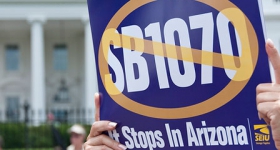One of my college friends works for the Foundation for the National Archives -- which, just by the way, is like the coolest job on earth, because she basically spends all day looking at pictures of history. Knowing my fascination with Asian American history and culture, my former suitemate will often send me images that she thinks I’d be interested in. This has been going on for several months, and it occurred to me that other people might be interested in them, too.
This image of Japanese Americans voting in San Bruno, California, really struck a chord with me as we wrap up last week's midterms elections. The full caption reads:
San Bruno, California. Entering Recreational Hall where election is being held for Councilmen. A general election for five members of the Tanforan Assembly center Advisory Council is being held on this day. The Issei [first-generation Japanese Americans] have never been able to vote before because of American naturalization laws, 06/16/1942
Traditionally, Asian Americans have the lowest voter turn-out rate of all ethnic groups in the US. An estimated seven million Asian Americans are eligible to vote but, according to the US Census Bureau 2008 survey, only about four million are registered. That puts Asian Americans at about 2.5 percent of the overall American voting block in 2008.
Now in 2010, the right to vote is something that many people take for granted. For me, this picture is a reminder as to just how recent it was that many groups of people were given that right. Between 1942 and 1976, many changes were made to immigration and naturalization laws to allow immigrants to obtain citizenship and to vote without racial prejudice. That’s definitely something I’ll be thinking about when I cast my vote in the 2012 elections, just 70 years after the first Issei cast their votes in 1942.
Further reading:
ACLU Voting Rights Act Timeline
Voice of America, Asian Americans Have Many of Same Election Day Concerns as Other Groups
Pew Research Center Publications, Dissecting the 2008 Electorate: Most Diverse in U.S. History
Photo Citation:
Still Picture Records Section, Special Media Archives Services Division (NWCS-S), National Archives at College Park, 8601 Adelphi Road, College Park, MD, 20740-6001










Comments
Thanks for your comment, ekb! You're absolutely right, Japanese Americans weren't given the right to become citizens until 1952 when the McCarran-Walter Act was passed. I had been kind of confused by the timeline, but figured maybe San Bruno had different voting laws or something, and I'm glad you were able to clarify the situation. The immigration/naturalization processes are so muddy that sometimes it's hard to figure out what happened when, why and how. In that case, in 2012, I'll be thinking about how it was only 60 years ago that the Issei were allowed to vote as US citizens.
The purpose of this post was to bring attention to Asian Americans in history. Whether propaganda or not, I think these images bring value to our understanding of Asian American history for what they show -- or don't show. WWII internment camps are not something that I think about on a regular basis, but you can bet that, today, I'll be thinking about what they went through and the rights/freedoms that we enjoy today. Thanks again for your contribution.
So sorry, everyone (Victoria included). We got caught up in the copyright questions of posting images from the National Archive -- and in the excitement overlooked a far more important detail: the particular year and therefore very vexed historical context of this photograph. 1942 or 1946? Big difference.
For the editorial fail, my apologies. Though to Victoria's point, that complicating context makes their act of voting all the more powerful -- and our own voting all the more necessary.